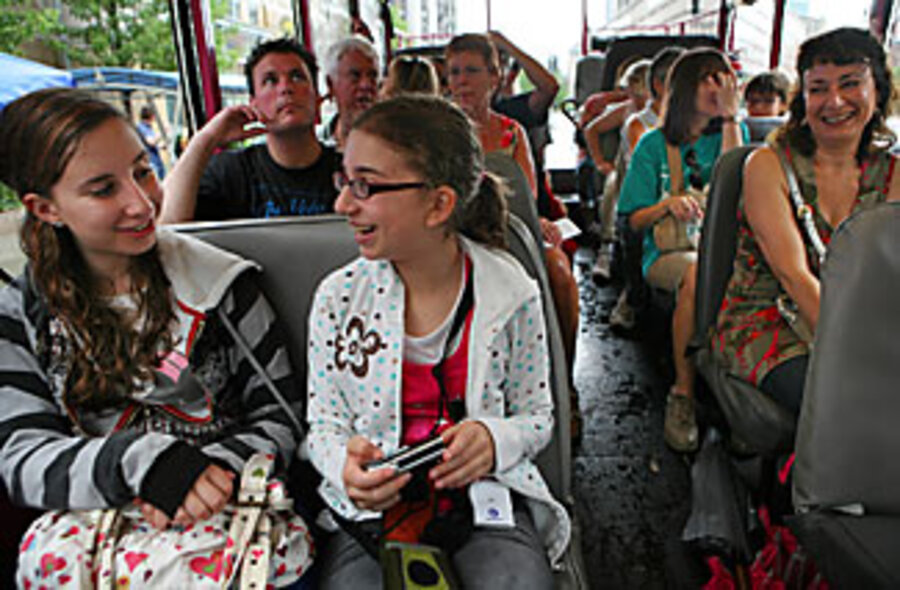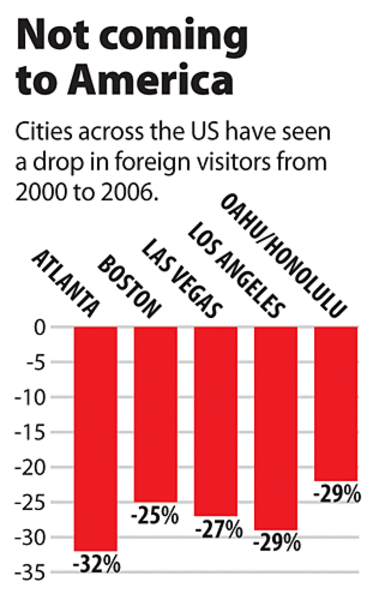Tourism rises globally, but not to U.S.
Loading...
| Washington
A recent headline in The Guardian of London – "America – more hassle than it's worth?" – underscores a stubborn global view that the United States is not an easy or a desirable place to visit.
It's a perception reflected in the numbers. The world's long-haul international travelers have jumped by 35 million since 2000, yet America has been largely overlooked by those new travelers, despite favorable exchange rates resulting from a weak dollar and attractions like Disney World and the Grand Canyon. In fact, the annual number of foreign visitors to the US is about 2 million lower than in 2000, leading travel-industry experts to figure that from 2000 to 2007, the US economy took a hit of about $150 billion.
This all comes at a time when the economy could use a little boost from free-spending foreigners.
With the economy anchored as voters' top concern for the fall elections, Congress is taking notice of the foreign-traveler deficit, considering ways to better communicate US entry requirements and to develop a "See America" promotional campaign. But even with that, it could be years before America's welcome recovers its lost luster, say travel experts.
"If you look at international travel as a pie, then the world pie is growing, but the US slice of it is shrinking – and that despite the fact that we are a great bargain," says Roger Dow, president of the Travel Industry Association (TIA), a Washington-based representative of the $740-billion-a-year travel industry.
International travelers toting overflowing shopping bags in Manhattan and those filling Houston's trendy restaurants are exceptions. In all other major US cities and destinations, the numbers of long-haul foreign visitors (which excludes border hoppers from Canada and Mexico) are down – with reasons ranging from perceptions of close scrutiny at airports to the residual impact of a poor US image abroad.
When The Times of London recently suggested that foreigners with a hankering for Mickey and Minnie could save themselves the hassle of US travel by substituting Paris Disneyland, or fill a cowboy craving by visiting France's horse-rich Camargue rather than the American West, it stung in traditional American tourist destinations. Foreign visitors to Orlando, Fla., dropped by one-third from 2000 to 2006; by nearly 40 percent over the same period to Anaheim, Calif. (read Disneyland); and by 22 percent to Las Vegas, a frequent entry point for foreigners to the Southwest.
Some Americans might respond with a jingoistic "Who needs 'em?" But Mr. Dow notes that in all 50 states, travel and tourism figure somewhere among the top four industries by economic impact.
The economic impact is not just on hotels, restaurants, Liberty Island ticket sales, and T-shirt hawkers.
Organizers of the annual international consumer electronics show in Las Vegas cite several reasons for thousands of lost visitors: an arduous visa process for potential show attendees, a perception of an unwelcoming America, and high-profile campaigns to draw visitors by countries with rival electronics shows. The result is lower sales for the mostly US electronics companies that make up the Las Vegas show. "We had 28,000 international visitors to the show this year [in January], but that number is easily off by several thousand from China alone because of our government's efforts to control the flow of visitors," says Gary Shapiro, president of the Consumer Electronics Association in Arlington, Va.
The foreign-visitor issue, he says, is one element of a "three-part problem" that also includes the high hurdles required of foreign students seeking to study in the US and restrictions on the entry of highly skilled workers. "It's a huge issue for our nation," he says.
On a recent trip to China, Mr. Shapiro met the owner of a chain of 1,200 electronics stores who said he'd love to visit the Las Vegas show – but can't get a visa. While Shapiro may not know why that particular visa request was denied, he does know about the process a Chinese businessperson, tourist, or student has to go through to get a visa.
As he describes it, the applicant must first get to the US Embassy or a city with a US consulate, wait in what can be a long line, and pay a $100 application fee, giving a full accounting of all financial assets. The applicant must then return to the embassy or consulate for a two-minute interview that results in approval for a visa or rejection.
"Meanwhile this person, who is wondering why he is putting himself through that, is hearing from the competition in Germany, 'Come to Germany!' " adds Shapiro, noting that Berlin holds a rival consumer electronics show.
The US government has gotten the message to some extent, working with foreign governments to extend visa-waiver programs to more countries and spending millions of dollars on programs to improve the reception of foreign visitors at key arrival airports. In April, the State Department and the Department of Homeland Security announced the expansion of the 2006 Model Ports Initiative to 18 additional airports: The goal is to streamline and make more pleasant the arrival process for foreign visitors.
But the US still does not have a campaign to promote American travel to foreigners, the only developed country not to have one. "As a country we've had this ... arrogance that people will struggle to get here, while other countries have to promote themselves," Shapiro says.
Congress seems convinced that this must change. More than 40 senators and 200 House members are cosponsoring a "travel promotion act" that would create a $200 million program – similar to what other developed countries already have. It would communicate US security and entry policies to foreigners while promoting the US as a travel destination.
The program would not require US tax dollars but would be a public-private partnership financed in part by a new fee on foreigners entering the US from visa-waiver countries and in part by the travel industry.
Still, promoters of the new program say Americans should understand the role they play in improving the climate for foreign visitors.
"People hear about rude treatment getting in here, and there can be some truth to that," says Dow of the TIA. But he also cites surveys showing that three-quarters of foreign visitors go home "feeling very good about America and Americans," he says. "If we had 10 million more people going home somewhere and saying, 'You know, they are pretty darn nice people,' " he adds, "it's pretty good public diplomacy."







